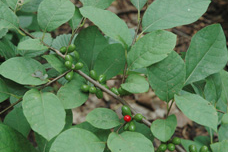As the cool air moves into October and the summer nights are fading into the campfire warmth, the flavors are starting to change. Autumn is associated with the warm spices of cinnamon, ginger, clove, nutmeg, and allspice. Hot apple cider, pumpkin pie, squashes and pumpkins. There is another Autumn staple in this part of the country…the native Spicebush!

Lindera benzoin, or as we call it Spicebush, is in the deciduous laurel family, and can be seen all throughout the forests and along the streams of the mid-Atlantic–right up and down the east coast. It grows in great numbers in the same forests that grow paw paw and sassafras, other Autumn staples. Before getting into the specifics of identification, there is more to learn about the character of Spicebush and the gifts Spicebush shares with us.

Spicebush’s bark, twigs, and leaves, both fresh and dried, can be made into a simple tea that creates a fresher, greener, and lighter cinnamon taste. Add the Spicebush berries while they are green for a hint of black pepper, and add while they are red for a strong allspice flavor. It is the seed inside the berry that brings the peppery fire, and the skins and pulp bring the smoky sweetness when ripe red. The North American Iroquois and Ojibwa tribes used Spicebush tea to treat sweating, colds, and as a diaphoretic for breaking fevers. It is also said to be good for encouraging blood circulation and relieving stagnant gas in the stomach.
What I appreciate the most is that it tastes incredible and brings us into a deeper relationship with the plants and ecologies that we live within and nearby. You can also dry the green berries and grind them into a local, native substitute for black pepper. The red berries can also be dried to replace or enhance allspice, nutmeg, and other warm spices. As a Jewish person, I also substitute allspice and clove for spicebush berries, both green and red, to create a more local, place-based spice mixture for ritual use at Havdallah, which marks the end of Shabbat. Also consider carefully breaking off a small twig and chewing on it throughout your hike to freshen your breath and brush your teeth a bit.

It has a simple leaf pattern that turns from dark green to slightly green-yellow over the changing seasons. Spicebush has little nubs and spots on it’s brown-grey bark that are used for respiration, so it breathes! Flowers look like little pale yellow scrunchies hanging in clusters off the tree. It enjoys part shade and part sun as a mid-level canopy tree. They also tend to grow near Sassafras Trees. Spicebush is also home to the Spicebush Swallowtail Butterfly and larvae, as well as the Tulip Tree Butterfly. Also, deers do not like the taste of spicebush, so it makes for good repellant.


Please watch this video from NPR to learn a bit more!
Thank you! Please take a walk through the woods and the parks to explore and find some Spicebush!

